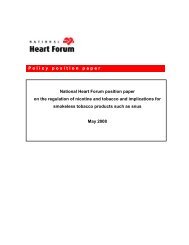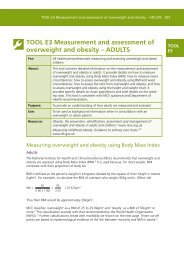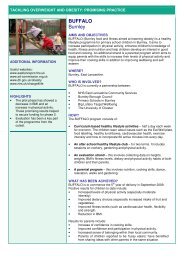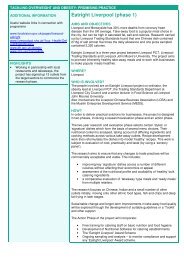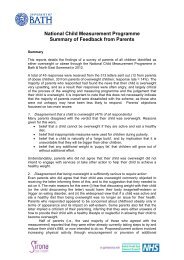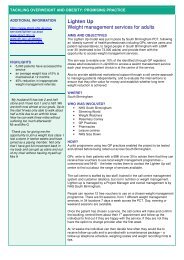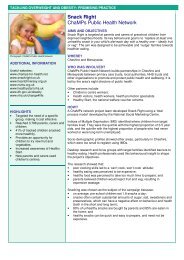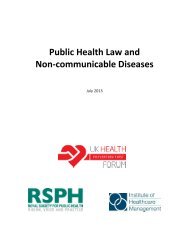The Challenge of Non-Communicable Diseases and Road Traffic ...
The Challenge of Non-Communicable Diseases and Road Traffic ...
The Challenge of Non-Communicable Diseases and Road Traffic ...
Create successful ePaper yourself
Turn your PDF publications into a flip-book with our unique Google optimized e-Paper software.
<strong>The</strong> <strong>Challenge</strong> <strong>of</strong> <strong>Non</strong>-communicable <strong>Diseases</strong> <strong>and</strong> <strong>Road</strong> <strong>Traffic</strong> Injuries in Sub-Saharan Africa: An Overview draws on a<br />
comprehensive review <strong>of</strong> the literature <strong>and</strong> on input from policy makers, researchers <strong>and</strong> practitioners to address four<br />
questions: (1) How is the growing burden <strong>of</strong> non-communicable diseases (NCDs) <strong>and</strong> road traffic injuries (RTIs) changing<br />
the epidemiology <strong>of</strong> Sub-Saharan Africa? (2) What determines <strong>and</strong> drives this burden, <strong>and</strong> what are the commonalities<br />
with communicable diseases? (3) What is the rationale for public intervention? And (4) How could resource-constrained<br />
governments approach NCD prevention <strong>and</strong> treatment <strong>and</strong> road safety in a comprehensive, effective <strong>and</strong> efficient way?<br />
<strong>The</strong> data show that action against NCDs <strong>and</strong> RTIs in Sub-Saharan Africa is needed, together with continued efforts to<br />
address communicable diseases <strong>and</strong> maternal <strong>and</strong> child health <strong>and</strong> reach the Millennium Development Goals (MDGs).<br />
<strong>The</strong> report suggests that NCDs/RTIs should not be tackled separately as a vertical program, nor should they displace<br />
communicable diseases as priorities. Instead, given resource constraints, <strong>and</strong> some shared determinants, characteristics,<br />
<strong>and</strong> interventions, there is scope for an integrated approach focusing on functions (prevention, treatment <strong>and</strong> care)<br />
rather than on disease categories.<br />
A healthier <strong>and</strong> more productive population is a critical factor for ensuring sustainable economic growth <strong>and</strong> social<br />
development over the medium <strong>and</strong> longer terms in Sub-Saharan Africa.<br />
“Countries will take different paths towards universal health<br />
coverage. <strong>The</strong>re is no single formula. However, today, an<br />
emerging field <strong>of</strong> global health delivery science is generating<br />
evidence <strong>and</strong> tools that <strong>of</strong>fer promising options for countries….<br />
For decades, energy has been spent in disputes opposing<br />
disease-specific ‘vertical’ service delivery models to integrated<br />
‘horizontal’ models. Delivery science is consolidating evidence<br />
on how some countries have solved this dilemma by creating<br />
a ‘diagonal’ approach: deliberately crafting priority diseasespecific<br />
programs to drive improvement in the wider health<br />
system…. Whether a country’s immediate priority is diabetes;<br />
malaria control; maternal health <strong>and</strong> child survival; or driving<br />
the ‘endgame’ on HIV/AIDS, a universal coverage framework<br />
can harness disease-specific programs diagonally to strengthen<br />
the system.”<br />
Dr. Jim Kim, President <strong>of</strong> the World Bank,<br />
World Health Assembly<br />
Geneva, 21 May 2013<br />
“As we start the journey <strong>of</strong> the next fifty years, we are clear<br />
about the task before us: to educate our populace, <strong>and</strong><br />
ensure healthy bodies <strong>and</strong> minds; to modernize <strong>and</strong> exp<strong>and</strong><br />
Africa’s infrastructure <strong>and</strong> connect our peoples <strong>and</strong> countries;<br />
to grow our agriculture <strong>and</strong> agro-businesses so that we can<br />
feed ourselves <strong>and</strong> the world; to use our natural resources<br />
to industrialize <strong>and</strong> grow our shared prosperity; to invest in<br />
science, technology, research <strong>and</strong> innovation as enablers <strong>of</strong><br />
rapid progress; <strong>and</strong> finally to empower women <strong>and</strong> youth as<br />
the drivers <strong>of</strong> Africa’s renaissance”.<br />
Dr. Nkosazana Diamini Zuma<br />
Chairperson <strong>of</strong> the African Union Commission<br />
Commemoration <strong>of</strong> the 50th anniversary <strong>of</strong> the<br />
Organization <strong>of</strong> African Unity (OAU) now the<br />
African Union (AU)<br />
Addis Ababa, 25 May 2013



